Revised and updated January 2023
The Marble Mountains, situated between Da Nang and Hoi An are a spectacular sight. This complex of five marble and limestone hills is a popular destination for tourists to explore due to its impressive caves, temples and nearby beaches.
Below the surface the five mountains’ sheer, porous limestone is punctuated by several caves and numerous tunnels, that are sprinkled with spectacular Buddhist and Hindu shrines.
Above the surface lies an array of pagodas, shrines, Buddhist statues and special vantage points where visitors can take in the stunning view of Hoi An’s nearby coastline.
The Marble Mountains can easily cast a spell on anyone, courtesy of its pagodas and statues as well as different caves, tunnels and breathtaking views of the surrounding area. You can get to the top by either climbing 156 stairs or by taking the elevator, which makes access available to tourists of all ages.
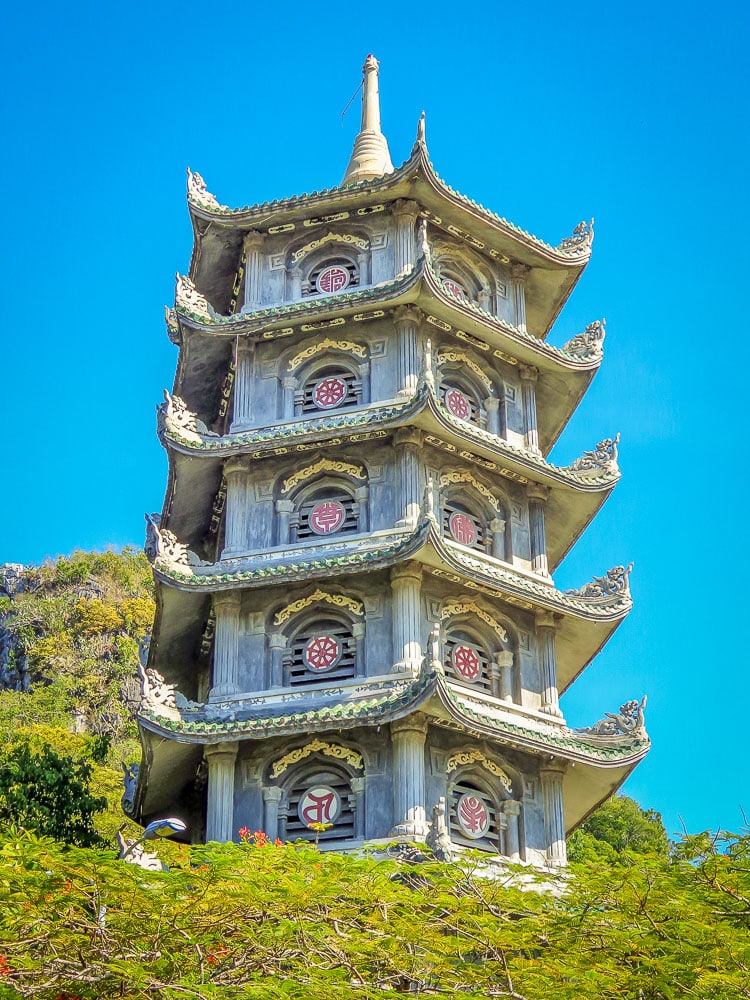
What are the Marble Mountains?
Initially, the Marble Mountains were sacred sites worshipped by the Cham people of Southern and Central Vietnam. Now, this group of five limestone and marble hills is considered to be one of the main attractions in Vietnam and an ongoing site of Buddhist religious significance.
These abrupt limestone and marble outcrops, although not large, stand in stark relief against the adjacent coastal floodplain. Below the surface the marble/limestone mix has been sculpted over time by the elements into incredible cave systems throughout. Above the surface winding walking trails link the cave entrances and stunning Buddhist statues, pagodas, shrines and panoramic viewing spots.
Visiting the Marble Mountains you will see stunning views both from within its caves and outwards towards Da Nang cityscape or nearby beaches. The marble itself ranges from gray-blue to yellow, red, and white depending on location, giving it a unique marbled look.
Tourists only have access to Thuy Son (Mountain of Water), one of the five hills. At Thuy Son you can take your time and enjoy the caves and pagodas you come across, while making your way to the top of the Marble Mountains. And once you reach the top you’ll find spectacular views across My Khe Beach and Non Nuoc Beach.
The Marble Mountains is a monument to the power of nature, geology and culture and their interconnections with each other.

History of the Marble Mountains
In the Beginning
The Marble Mountains were an important site for Hindu Cham people for over a thousand years prior to the 16th century. The Cham created marble temples for Hindu worship, and some of their ancient sculptures remain today.
The Marble Mountains have been a part of the culture and folklore in Central Vietnam for centuries. According to legend they are the offspring of a dragon and are known as “Ngu Hanh Son” which translates to “Five Elements Mountains”. The five essential elements are: Kim (metal), Tho (earth), Moc (wood), Hoa (fire), and Thuy (water). Only Thuy Son, the Water Mountain, which has the highest summit, is accessible to tourists.
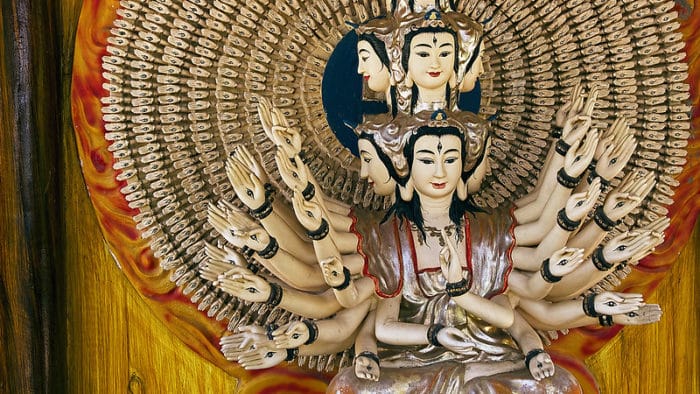
Another less interesting version claims Vietnamese Emperor Minh Mang named the mountains “Ngu Hanh Son” (The Five Elements Mountains), in 1825 for the first time, centuries after the decline of the Cham Empire. Whatever the case, by the early 1800s the mountains had become an important spiritual destination with Buddhist sanctuaries for Mahayana Buddhists, as well as the Vietnamese aristocracy.
Many years later, during the French colonial period, a group of French geologists re-named them the ‘Marble Mountains’, as we know them today.
During the French Colonial War the strategic advantage of the Marble Mountains took center stage. At this time Huyen Khong Cave was an invaluable, secret command post for local revolutionaries and a forward base from which to stage guerrilla assaults.
Vietnamese/American War and Beyond
These limestone mountains played an important role in the Vietnam War too.
Once a sacred site, Huyen Khong Cave once again served as a garrison, used by the Americans and the Southern Vietnamese government. However, after many assaults on the Marble Mountains, the caves fell under Communist control. The People’s Liberation Armed Forces (PLAF) established a secret field hospital there.
At the same time, thanks to its panoramic views, the Marble Mountains were successfully used to spy on American forces at nearby My Khe Beach.
One famous story tells of 17 Buddhist nuns shooting down two American planes from the mountains. The truth may be a stretched in some of the stories about the Marble Mountains but whatever the case, it is certainly true that guerrilla fighters, military scouts and others found sanctuary in ‘Marble Mountain’ and used it to advantage over the years.
As one can imagine, much of the area was damaged during this time, and subsequent renovations have taken place over the last few decades.
Consider getting a guide if you’re interested in exploring this very rich history further.
When to Visit the Marble Mountains
Thanks to their location, you can visit the Marble Mountains any time of the year. However, it is recommended to do so in the dry season (January-August), since the marble stairs can be slippery and potentially dangerous in the rainy season (September-December). Also, in order to avoid the crowds and the midday heat, try to go as early as possible and start your visit before 9am.
The first buses begin to arrive around 9:15 a.m. so it’s a good idea to get in ahead of the hoards that come with by the bus load. Alternatively, come later in the day, after the bus tours have left, approximately between 4 to 5:30 p.m. Visiting at these times has the added benefit that you avoid the hottest part of the day and have the best photographic light.
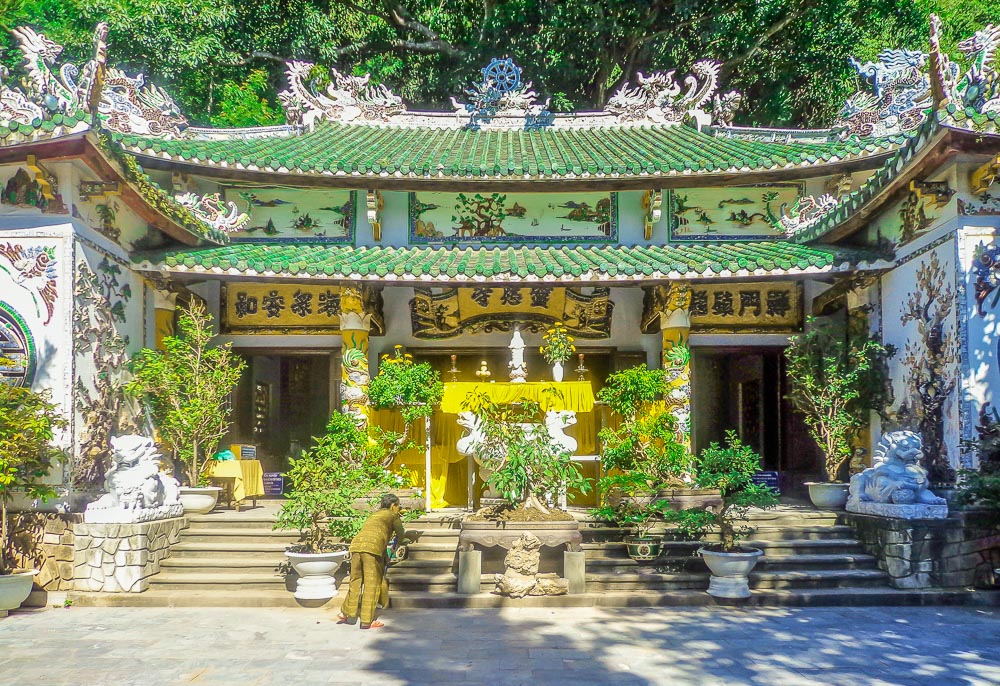
How to Get to the Marble Mountains
How far are the Marble Mountains from Hoi An and Da Nang?
The Marble Mountains are only 20 kms north or a 30-minute drive from Hoi An Ancient Town, which makes them one of the most popular attractions for tourists staying there. Find our overview to Hoi An here.
This UNESCO World Heritage Site is even closer to Da Nang – you can visit the Marble Mountains in a 15 minute drive from the airport.
Getting from Hoi An to Marble Mountains
Being so close to Hoi An, it is easy to reach the Marble Mountains, by taxi, private car or motorbike. Below are the main options. Also see Hoi An to Da Nang Airport for information about moving between Hoi An and Da Nang.
Taxi
If you would like to have a more comfortable ride, you can book a taxi for either a one-way journey or ‘wait and return’, in case you are not planning to spend too much time exploring the area. If you choose a metered taxi, you should expect to pay approximately 250,000 VND (11 USD) for a one-way ride from Hoi An to the Marble Mountains.
Motorbike
If you do not have a recognized driving license, it’s safer to use other methods than ride a motorbike, but if you do have one, then you can easily reach Marble Mountains by taking the Le Van Hien highway. When arriving at your destination, you will find the ticket office on Huyen Tran Cong Chua Street. As for the parking, you can let your car/motorbike rest in the parking lot at gate number two, for 10,000 VND (0.40 USD).
Tip: Before hitting the road, check out our guide to Vietnam Road Rules.
Private Driver
A private driver is a great option, he or she will wait for you or collect you at an appointed time. The transport round trip should be in the vicinity of 400,000 VND including waiting time.
Organized Tours
Marble Mountains tours abound. Pick up is from your hotel (or a set meeting place) and Marble Mountain tours are often combined with a visit to the Lady Buddha or a tour of Da Nang City. At just 35USD or so they also provide an attractive option.
Parking
For those who drive parking is available in a designated parking lot at gate two for 10,000 VND (.40c USD).
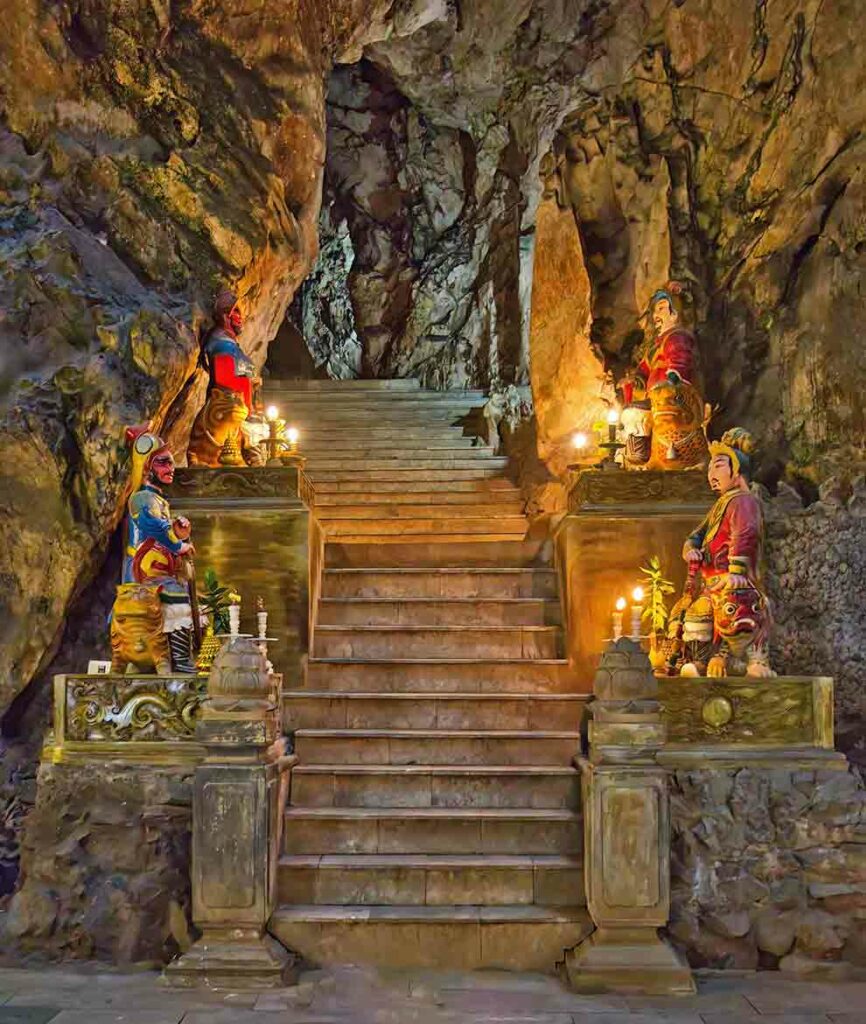
Ticketing and Tips
Ticketing
You can visit the Marble Mountains all year round, and Marble Mountain opening hours are between 7am and 5.30pm. The Marble Mountains entry fee 40,000 VND/ 1.70 USD and you do not have to buy in advance. At the ticket office, you can also purchase a map of Mt. Thuy’s attractions for only 15,000 VND (0.65 USD). However, there are plenty of large, detailed signs with maps throughout the area.
You can get to the top quickly by accessing the elevator for just 15,000 VND extra. Many take this option and return via the 156-step stairs.
Marble Mountains Tickets
Entrance ticket: 40,000 VND (1.70 USD)
Shades Cave: 20,000 VND (0.85 USD)
One-way elevator ticket: 15,000 VND (0.65 USD)
Map: 15,000 VND (0.65 USD)
How long does it take to climb Marble Mountains?
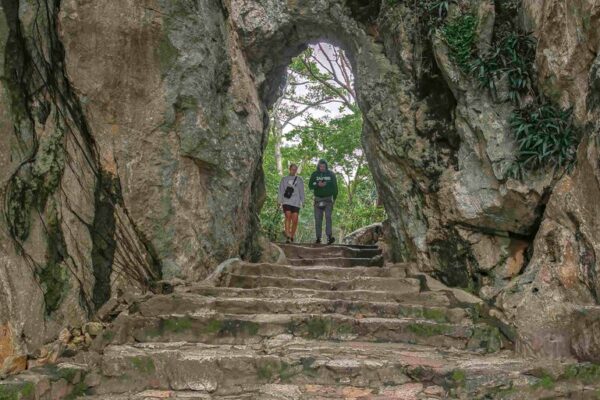

Depending on your interests and also on how you want to explore the Marble Mountains – by climbing the 156 stairs or by taking the elevator, which costs an additional 15,000 VND (0.65 USD) per person, each way – one visit can take between 1.5 and 4 hours.
What to wear for Marble Mountains
When visiting the Marble Mountains, make sure you wear breathable clothes and good footwear, since the steps can be challenging at times. On top of that, if you are visiting during the summer, make sure you wear a hat and sunscreen. Lastly, cold drinks and coconuts are sold on the mountain so make sure you stay hydrated during the day. Shorts are fine to wear when visiting.
What to See at the Marble Mountains
The Caves
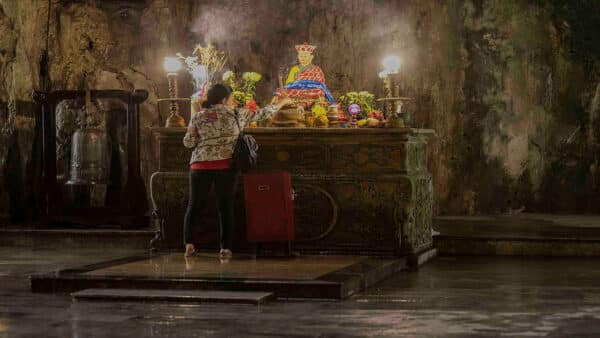
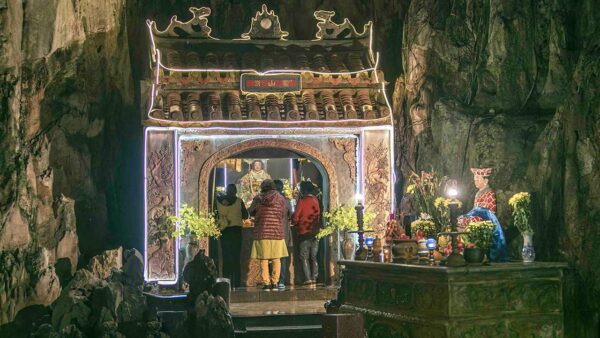
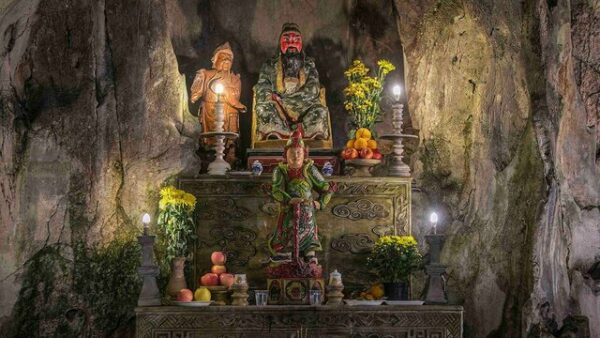
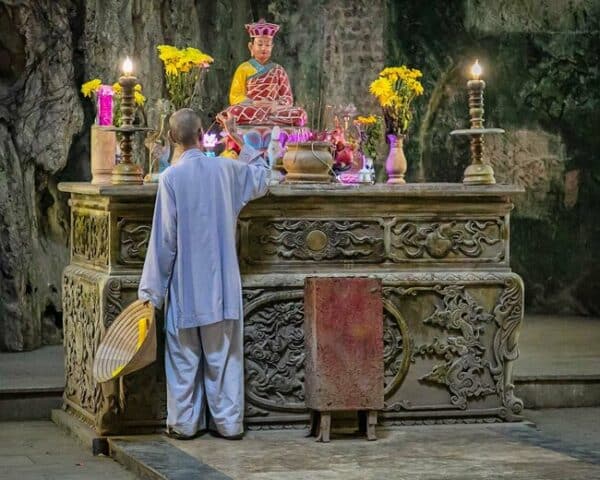
As noted above the caves at the Marble Mountains provided excellent refuge during the Vietnam/American war. Also of interest is that one of the Marble Mountains’ caves is thought to have a connection with the sea, by a subterranean river that may begin from its bottom. Although there is much to see at the Marble Mountains, it’s the caves that really make it an attraction of the first rank and the heavy tourism notwithstanding, the shrines and alters at the Marble Mountains remain places of serious prayer and religious devotion.
Huyen Cong Cave
Huyen Cong Cave is a standout with two Buddhist shrines, 4 temples including a 5-meter Gautama Buddha in the cave face. Below the Gautama Buddha, Ksitigarbha Bodhisattva is worshiped. To its left side, there is a temple for worship of Ngoc Phi goddess who owns the Marble Mountains according to ancient belief. A smaller temple for her younger sister, Loi Phi goddess is on the other side. Locals come to pray for good health, favorable careers, safety and children
Elsewhere, sits the largest temple, Trang Nghiem Tu (1825 and rebuilt in 1907 after typhoon damage). It’s dedicated to Lady Buddha in the middle, Quan Cong on the left and the God of Matchmaking and Marriage on the right. Visitors who are seeking a partner come here. A short walk from it, are 2 breast-like rock formations. Many local infertile women visit this detail looking for a miracle.
Feature lighting and incense augment the filtered light from above in the Huyen Cong Cave and between noon and 2pm shafts of sunlight invade in an impressive display. A sacred site for the both the Cham Hindus and the Buddhists who followed them, Huyen Cong Cave was home to sculptures that dated back to the 10th century.
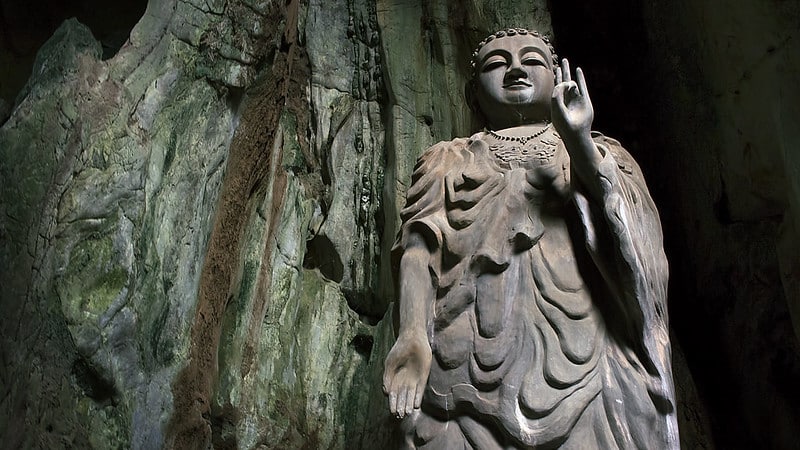
Heaven Cave (Van Thong Cave)
Van Thong means “way to the Heaven” and is so-called because visitors can climb up to high elevations of the mountain inside this tunnel-like grotto.
Push past the original chamber along a narrow tunnel to the main chamber. Here glorious stalactites appear as if they were diamonds under colorful sparkling lights. This ambient lighting creates an effect similar to stars twinkling in a night sky.
At the back of this chamber is a far smaller tunnel which is not for the elderly or the infirm. Push through this however and you’ll be rewarded on the other side with glorious views from the summit of Heaven Peak. Don’t return the way you came or you’ll create mayhem. A separate track will take you back down to familiar territory.
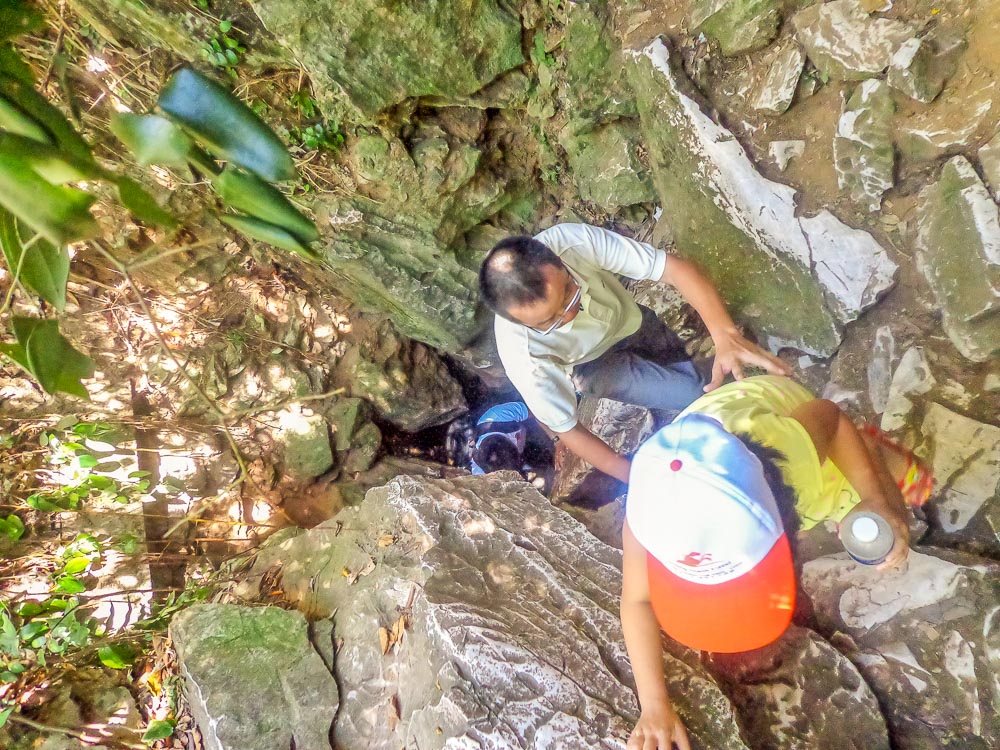
Am Phu Cave (Heaven’s Roof)
Sitting at the foot of Thuy Son, Am Phu Cave is the largest and most spectacular cave on the marble mountain. Am Phu means ‘heaven’s roof’, named after a rocky outcrop resembling a roof above the entrance. It also goes by the name ‘Hell Cave’ showcasing two sets of steps – one leading to ‘heaven’ and the other to ‘hell’.
Stepping through the entrance you’ll be amazed by its enormous size. The ceiling is incredibly high with broad galleries that branch off in all directions. You can explore for hours here; ancient Cham statues are widely scattered along with several other artifacts from 9th–12th centuries. Archaeologists have also discovered some remains of Neolithic humans here.
Explore further and you’ll come across several pools and smaller caves hidden away in the maze of halls and corridors. This wonderland will stay with you long after you leave but during the war it served a different purpose. It proved to be an excellent hiding place under the Americans noses with its maze of interconnected ‘rooms’ and fresh water sources.
Am Phu Cave is also associated with Buddhist notions to do with the journey of the dead from this life to the next.

Tang Chon Cave
Behind Linh Ung Pagoda, is a series of open-ceiling caves, collectively known as Tang Chon Cave which was traditionally a site for Buddhist meditation and other Buddhist practice. Nearby are three tall honey locust trees that were planted 160 years ago.
The largest chamber consists of 3 altars for worship: the Great Buddha in the middle, Taoist gods and the Mother goddesses on either side. To the right is a small grotto with two marble statues depicting fairy men playing chess together; on the other side are three caves.
Linh Nham Cave
Access to this small cave is from the back of the Tam Thai Pagoda. At Linh Nham Pagoda an alter sits an alter to the God of Heaven that came from Huyen Khong cave. In the past, people placed the Lady Buddha there.
The Pagodas

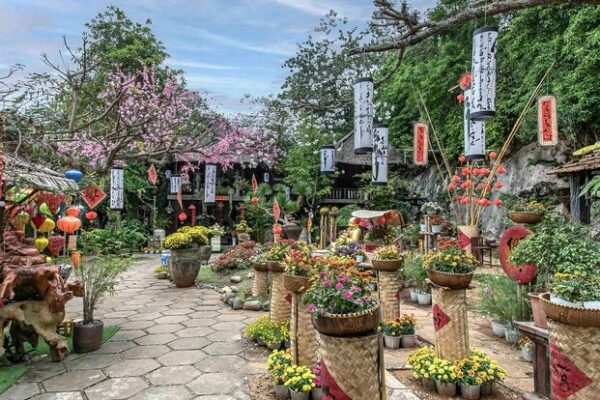
In the Marble Mountains the Linh Ung Pagoda stands head and shoulders above the rest. Established by the Nguyen Kings in the early 1825 as the National Pagoda, it dominates its area. Also of interest among the ancient pagodas is the Tam Thai Pagoda, built in its current form in 1930, its first form dates back to the 17th century. It has been destroyed, rebuilt, and renovated many times. Most recently a powerful storm completely destroyed the little that was left after the Vietnam War in 1991 only to be rebuilt again.
Perhaps the most striking pagoda is the Xa Loi Tower that can be seen from the road. This 30-meter high tower has seven floors. Inside the tower, there are nearly 200 Buddhas.
The View from the Peak of Mt Thy
Standing atop the peak of Mt. Thy, visitors are rewarded with a panoramic view of Da Nang City, its beach and surrounding countryside and islands. On clear days you can even see as far Hoi An on the horizon. It’s an awe-inspiring sight! Sunset is especially beautiful here.
Throughout your visit to Marble Mountains you’ll find myriad opportunities to soak up and photograph the surrounding plain below, the ocean and China Beach nearby, the other marble mountains and the large mountains on the western horizon, towards Laos. Look for little tracks that reveal special vantage points as well as the well-signposted lookouts as well as the peak of Mt Thy.
The Marble Sculptures
‘Marble Mountain’ is also famous for sculpting marble, though in an effort to preserve the site, it is no longer quarried there but sourced elsewhere. As you approach, you see marble statues, magnificent and massive, in numerous showrooms dominating the roadside. They are worth a visit on their own.
Aimed at wealthy Vietnamese and Chinese tourists, these statues are truly amazing and if you fancy a couple of 20-feet-tall lions in your backyard then here’s your chance. There’s jewelry on sale as well as beautifully carved, whopping marble chess sets. Smaller carvings may appeal but they’re hard to settle for once you’ve stared into the eyes of an 18-foot, laughing minotaur.
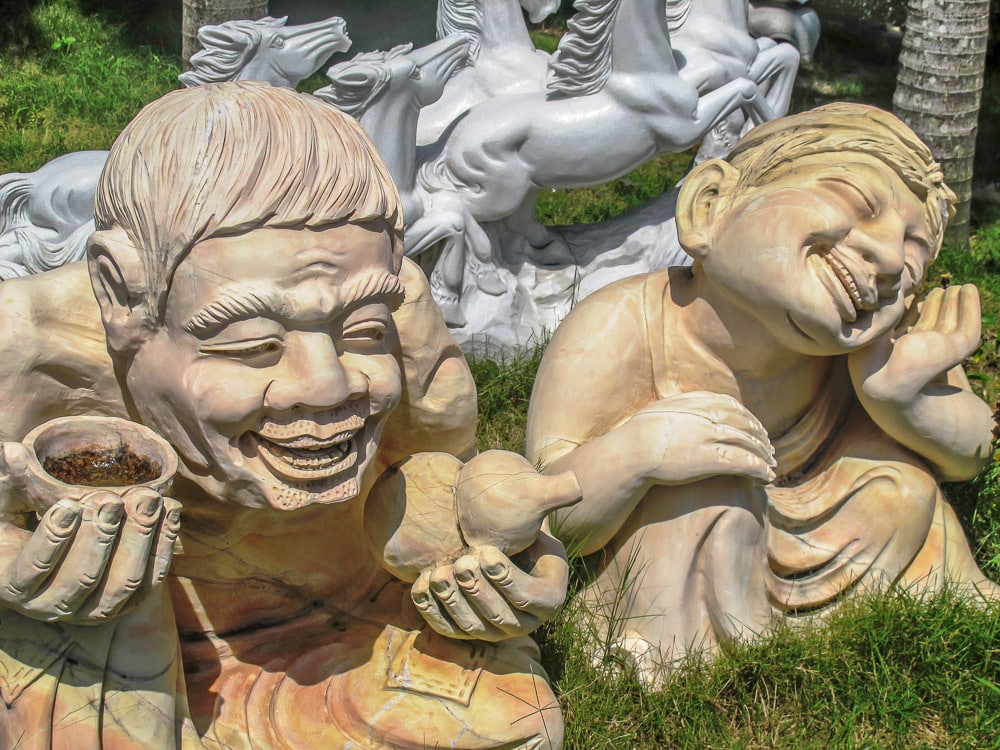
Frequently Asked Questions
There are a variety of tours that offer trips to the Marble Mountains. But it is cheaper to visit on your own for a day trip especially if you have your own transport. Even if you hire your own driver it will be cheaper to go mon your own as it takes roughly an hour and a half to view the sights at Mt. Thuy and costs only 40,000 VND (1.70 USD) per person. But cost isn’t the only consideration. Organized tours come with in-built guides who often have much to offer and many are packaged with other sites. For example, a Lady Buddha visit is often packaged with a Marble Mountains visit. And there’s something to be said for hotel pick-ups and drop-offs.
According to a local legend, a dragon emerged from the sea on Non Nuoc beach and laid an egg. A thousand days and a thousand nights after the egg hatched a beautiful girl. The egg fragments were left on the beach and eventually turned into five mystical marble mountains. This natural wonder was first adapted by the Cham civilization for spiritual purposes for many centuries before the 1500s and then by Buddhists in the years that followed. Emperor Minh Mang made further contributions after visiting in 1825.
The Marble Mountains attract busloads of tourists for good reason. This complex of caves, pagodas and panoramic views offers something very special and the elevator makes access extremely easy for visitors of all ages.
You can take an elevator that will get you to the top straight away or you can take the stairs that will take 15 – 20 minutes. To see everything there is to see will take between 1.5 and 3 hours for most.
After crossing the Marble Mountains off your bucket list, make sure you check out other important attractions in Hoi An and surrounding area.
Other Great Day Trips
Other great day trips in the Hoi An – Da Nang area include Monkey Mountain (Son Tra) and Lady Buddha, My Son and Ba Na Hills.